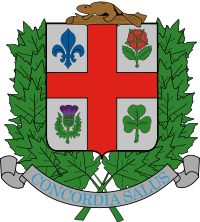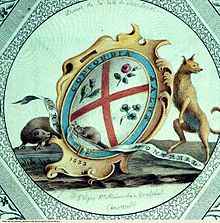- Coat of arms of Montreal
-
The coat of arms of the city of Montreal 
Information Date of origin 21 March 1938 Shield Argent a cross gules between a fleur de lys azure, a rose slipped and leaved, a thistle slipped and leaved and a trefoil proper, the whole encircled by a wreath of sugar maple and ensigned by a beaver upon a log proper. Motto Concordia Salus, Latin for "salvation through harmony." The first coat of arms of Montreal was designed by Jacques Viger, the city's first mayor, and adopted in 1833 by the city councillors. Modifications were made some one hundred five years later and adopted on 21 March 1938, resulting in the version currently in use. The coat of arms was the only city emblem representing Montreal until 1981 when a stylized logo was also developed for common daily use, reserving the coat of arms for ceremonial events and occasions.
Contents
History
The first coat of arms was displayed on white shield, which had a red saltire with four different charges between each of the arms, representative of the four main components of the population as viewed by Mayor Jacques Viger and the city council in 1833 when the coat of arms were designed and adopted. To the top, a rose was for the English heritage of the population, the dexter a thistle for the Scots, the sinister a sprig of clover for the Irish heritage of the city and to the bottom base a beaver for the French that originally settled the territory and traded in furs.
In 1938, the city council requested the coat of arms be updated to better reflect Montreal's population. The changes replaced the saltire with a cross, which then was reminiscent of both the St. George's Cross often associated with England and also with Christian missionary missions that could represent the principles of the French Catholics that originally founded the city. The beaver had become a symbol of the whole of Montreal and of the industriousness of the city by this time period, no longer merely representing the original French settlers, and was moved to ensign the shield. In the place of the beaver on the shield, a blue fleur de lys was added to symbolize the descendants of the original French settlers. The rose, thistle and clover remained. The shield was surrounded by a wreath made of sugar maple leaf to symbolize the amicable relations between the various elements of Montreal's population and an allusion to the maple as a national emblem of Canada. The scroll and motto below the shield read Concordia Salus, a Latin phrase translated as "Salvation through harmony."[1]
National symbols
The four flora designs found upon the shield are themselves each a traditional national symbols in their own standing, alluding to a specific historical device used by a state or nation.




A fleur de lys. The Red Rose of Lancaster. A trefoil or shamrock. A thistle. The fleur de lys was long used by the French Royal Houses, such as the House of Bourbon, in their coat of arms and was found upon the national flag of the French during this time, and was also used as a mark of honour or favour by the King of France. The first European settlers in possession of the Island of Montreal hailed from France, and thus are represented by this symbol.
The Red Rose of Lancaster was used as a symbol of the English Royal House of Lancaster, and has become, with the White Rose of York and Tudor Rose, a symbol of the English people as well.
Found in various folklore of the Scots since Roman times, the thistle has also been long used in the compartment of the Scottish royal coat of arms, and has been symbolic of the Scottish people long before heraldry.
Traditionally known as a trefoil, the shamrock was a symbol to early Irish Christians of the trinity, is has endured to become a symbol of the Irish people along with the harp of Brian Boru.
Logo
In 1981, with an attempt to modernize the city's emblems, Montreal introduced a logo for common municipal use, while the coat of arms would be reserved for the most formal of ceremonies and events. The device consists of the city's name with accent mark as found with the French spelling and a stylized rosette that is itself composed of four hearts. Officially, the type is to be in black and the rosette in red, but a few variations exist for printing purposes when the set colours would not contrast well on documents.[2]
Greater Montreal attempted to unify the City of Montreal with the other eighty-one surrounding municipalities under one logo in 2006. The logo that was introduced consisted of a stylized 'M' meant to look, as the design firm put it, "deliberately chubby, very welcoming, like a comfy chair."[3] However, the logo received much negative criticism for its "patchwork of hot pink, tangerine, rhubarb, turquoise and green apple",[3] that was viewed as childish in implement and likened to clown paint, Smarties, jelly beans, garbage and even vomit. Public sentiment grew increasingly negative when it was discovered the cost of the ill-received design was $487,000 paid out from the public fund.[3] Montreal itself continues to use the 1981 logo, and even Greater Montreal has since dropped the design they themselves introduced.[4]
See also
References
- ^ "What do the symbols on Montréal's coat of arms mean?". Centre d'histoire de Montréal, Ville de Montréal. http://ville.montreal.qc.ca/portal/page?_pageid=2759,3090868&_dad=portal&_schema=PORTAL. Retrieved 19 July 2009.
- ^ "The Ville de Montréal logo". Ville de Montréal. http://www2.ville.montreal.qc.ca/divers/identite_montreal_a.shtm. Retrieved 24 November 2009.
- ^ a b c "Montreal's new logo has people seeing red (and pink, and tangerine)". National Post. http://network.nationalpost.com/np/blogs/posted/archive/2008/10/29/montreal-s-half-million-dollar-logo.aspx. Retrieved 19 July 2009.
- ^ "Logo". Communauté métropolitaine de Montréal. http://www.cmm.qc.ca/index.php?id=326. Retrieved 19 July 2009.
External links
- "Montreal Coat of Arms (Engraving by John Henry Walker)". McCord Museum. http://www.mccord-museum.qc.ca/en/collection/artifacts/M930.50.1.216§ion=196.
- "The City of Montréal's First Coat of Arms (Detail of coloured engraving by William Berczy)". Gestion de documents et archives, Ville de Montréal. http://www2.ville.montreal.qc.ca/archives/500ans/portail_archives_en/rep_chapitre6/chap6_theme4_doc11_page1.html.
 Heraldry in Canada
Heraldry in CanadaOrganizations National arms Provincial and
territorial armsMunicipal arms
of capital citiesOttawa · Charlottetown · Edmonton · Fredericton · Halifax · Iqaluit · Quebec City · Regina · St. John's · Toronto · Victoria · Whitehorse · Winnipeg · Yellowknife · MoreRelated Montreal Features 
History Expo 67 · Hochelaga · Mayors · Montreal Urban Community · October Crisis · Oldest buildings and structures · Reorganization of Montreal · 1976 Summer Olympics · Timeline · National Historic Sites of CanadaGeography Economy Politics Public Services Education Commission scolaire de Montréal · Commission scolaire Marguerite-Bourgeoys · Concordia University · English Montreal School Board · Jewish Public Library · Lester B. Pearson School Board · List of schools and libraries · McGill University · Montreal Public Libraries Network · Université de Montréal · Université du Québec à MontréalCulture Architecture · Cuisine · Festivals and parades · Films · Media · Music groups · Shopping malls · Sport · TourismTransportation  Category ·
Category ·  Portal ·
Portal ·  WikiProjectCategories:
WikiProjectCategories:- Coats of arms of cities
- Canadian municipal coats of arms
- Municipal government of Montreal
Wikimedia Foundation. 2010.


